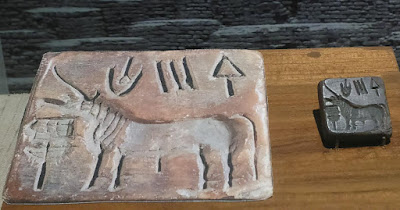History revisited
The existential threat posed by the American warships in 1853 led to deep divisions with the ruling elite and the population.
A Japanese print showing three men, believed to be Commander Anan, age 54; Perry, age 49; and Captain Henry Adams, age 59, who opened up Japan to the west | Library of Congress/Wikimedia Commons [Licnesed under CC BY Public Domain Mark 1.0]
Hamish Todd
December 26th 2018
"During the Meiji Period (1868-1912), Japan was transformed from a feudal society where power lay in the hands of the Tokugawa Shoguns and hundreds of local lords or Daimyo controlling a patchwork of fiefdoms, to a centralised, constitutional state under the nominal leadership of Emperor Mutsuhito (1852-1912). This transition was marked by the inauguration of the new reign name of Meiji or “Enlightened Rule” on October 23, 1868.
To commemorate this major anniversary, the British Library has digitised a manuscript handscroll Or.16453 depicting the arrival in Japanese waters in July 1853 of the American Commodore Matthew Calbraith Perry (1794-1858) and his squadron of four warships. Perry’s arrival triggered a long chain of events that led ultimately to the revolution of 1868."
Read article: Scrollin
The existential threat posed by the American warships in 1853 led to deep divisions with the ruling elite and the population.
A Japanese print showing three men, believed to be Commander Anan, age 54; Perry, age 49; and Captain Henry Adams, age 59, who opened up Japan to the west | Library of Congress/Wikimedia Commons [Licnesed under CC BY Public Domain Mark 1.0]
Hamish Todd
December 26th 2018
"During the Meiji Period (1868-1912), Japan was transformed from a feudal society where power lay in the hands of the Tokugawa Shoguns and hundreds of local lords or Daimyo controlling a patchwork of fiefdoms, to a centralised, constitutional state under the nominal leadership of Emperor Mutsuhito (1852-1912). This transition was marked by the inauguration of the new reign name of Meiji or “Enlightened Rule” on October 23, 1868.
To commemorate this major anniversary, the British Library has digitised a manuscript handscroll Or.16453 depicting the arrival in Japanese waters in July 1853 of the American Commodore Matthew Calbraith Perry (1794-1858) and his squadron of four warships. Perry’s arrival triggered a long chain of events that led ultimately to the revolution of 1868."
Read article: Scrollin





